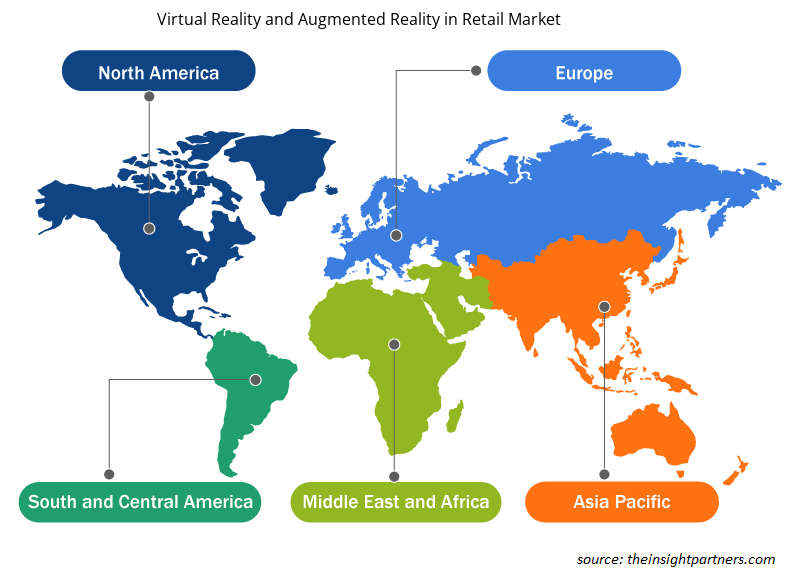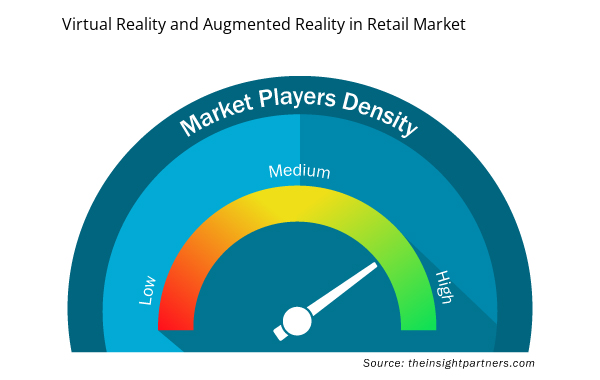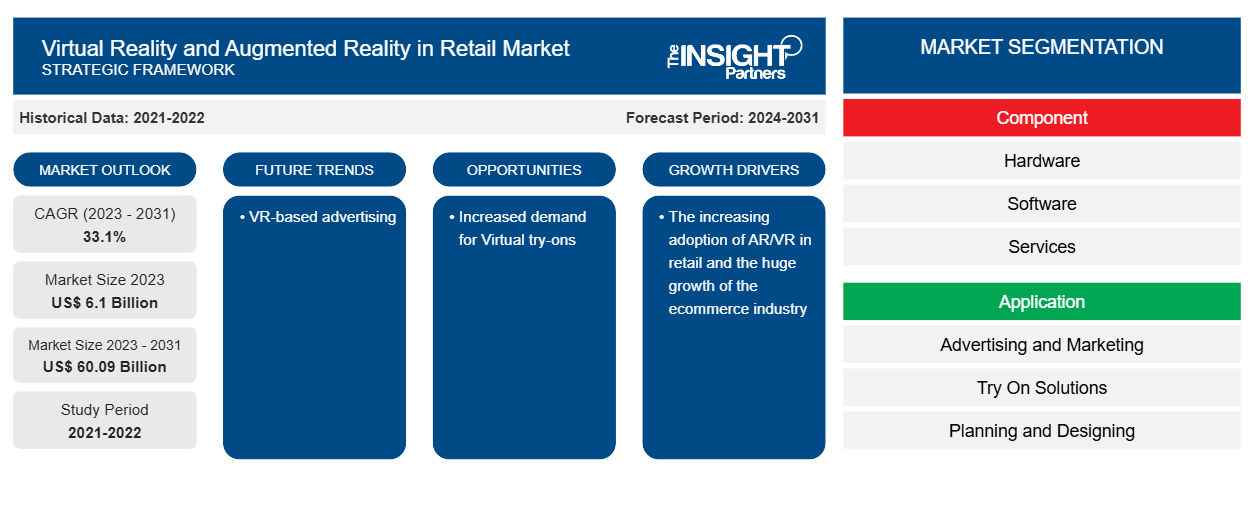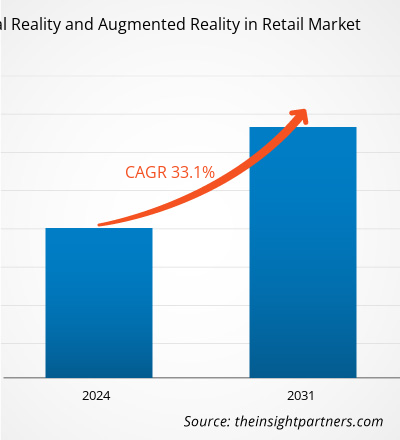Se proyecta que la realidad virtual y la realidad aumentada en el mercado minorista alcancen los 60.090 millones de dólares en 2031, frente a los 6.100 millones de dólares en 2023. Se espera que la realidad virtual y la realidad aumentada en el mercado minorista registren una CAGR del 33,1 % durante 2023-2031. Es probable que la publicidad basada en VR siga siendo una tendencia clave en el mercado.CAGR of 33.1% during 2023–2031. VR-based advertising is likely to remain a key trend in the market.
Realidad virtual y realidad aumentada en el análisis del mercado minorista
La realidad virtual y la realidad aumentada en el comercio minorista incluyen perspectivas de crecimiento debido a las tendencias actuales del mercado y su impacto previsible durante el período de pronóstico. La realidad virtual y la realidad aumentada en el comercio minorista están creciendo debido a factores como la creciente adopción de AR/VR en el comercio minorista y el enorme crecimiento de la industria del comercio electrónico. La mayor demanda de pruebas virtuales brinda oportunidades lucrativas para la realidad virtual y la realidad aumentada en el comercio minorista.
Descripción general del mercado de realidad virtual y realidad aumentada en el comercio minorista
La realidad virtual (RV) y la realidad aumentada (RA) están transformando el panorama minorista al ofrecer experiencias de compra inmersivas e interactivas. La RV crea un entorno totalmente digital donde los clientes pueden explorar tiendas virtuales, visualizar productos en 3D e incluso probarse ropa virtualmente. La RA, por otro lado, superpone información digital sobre el mundo real, lo que permite a los compradores ver cómo lucirían los muebles en sus hogares o cómo luciría el maquillaje en sus rostros mediante aplicaciones de teléfonos inteligentes o espejos inteligentes. Ambas tecnologías permiten a los minoristas cerrar la brecha entre las compras en línea y en la tienda, mejorar la visualización de los productos, reducir las devoluciones y crear experiencias de marca atractivas que pueden impulsar la participación del cliente y las ventas.
Personalice este informe según sus necesidades
Obtendrá personalización en cualquier informe, sin cargo, incluidas partes de este informe o análisis a nivel de país, paquete de datos de Excel, así como también grandes ofertas y descuentos para empresas emergentes y universidades.
- Obtenga las principales tendencias clave del mercado de este informe.Esta muestra GRATUITA incluirá análisis de datos, desde tendencias del mercado hasta estimaciones y pronósticos.
Realidad virtual y realidad aumentada en el mercado minorista: impulsores y oportunidades
La creciente adopción de AR/VR en el comercio minorista favorece el mercado
Uno de los principales sectores que ha sufrido el impacto de la era digital es el comercio minorista. Los minoristas más importantes, como Walmart, Alibaba y Amazon, invierten activamente en tecnologías de vanguardia para ofrecer servicios más individualizados e interactivos a sus clientes. Tres componentes fundamentales del comercio minorista inteligente son la mayor comodidad, la personalización y la personalización. Las soluciones innovadoras, como las aplicaciones impulsadas por la realidad aumentada y la realidad virtual, están ganando popularidad. Muchos comercios minoristas han comenzado a adoptar la tecnología de realidad aumentada y realidad virtual después de que gigantes minoristas como Wayfair, Lowe's e Ikea lo hicieran. Por ejemplo, se espera que más de mil millones de personas utilicen productos de realidad aumentada. La cifra es asombrosa. La realidad virtual y aumentada facilita a los clientes identificar y probar cosas antes de comprar. La navegación por los grandes centros comerciales será más sencilla gracias al uso de la realidad aumentada.Alibaba, and Amazon, actively invest in cutting-edge retail technologies in order to provide more individualized and interactive services to their customers. Three fundamental components of smart retail are increased convenience, personalization, and customization. Innovative solutions like applications powered by AR and VR are growing in popularity. Many retail businesses have started to adopt AR/VR technology after retail giants like Wayfair, Lowe's, and Ikea. For instance, more than 1 billion people are expected to use augmented reality products. The number is staggering. Virtual and augmented reality makes it easier for customers to identify and try things before buying. Huge shopping mall navigation will be made easier with the use of augmented reality.
Mayor demanda de pruebas virtualesTry-Ons
La mayor demanda de pruebas virtuales presenta oportunidades significativas para la realidad virtual y aumentada en el crecimiento del mercado minorista. Al permitir que los clientes visualicen los productos con mayor precisión antes de la compra, las pruebas virtuales pueden reducir significativamente las tasas de devolución. Esto ahorra dinero a los minoristas en envío y reposición, lo que mejora la rentabilidad. Además, a medida que los clientes ganan confianza en sus compras en línea a través de pruebas virtuales, es más probable que compren artículos sin verlos en persona primero. Esto puede impulsar las ventas de comercio electrónico, especialmente en categorías como ropa y cosméticos . Las pruebas virtuales ofrecen una experiencia de compra novedosa e interactiva que puede aumentar la participación y la satisfacción del cliente. Esto puede generar una mayor lealtad a la marca y compras repetidas.try-ons presents significant opportunities for VR and AR in retail market growth. By allowing customers to visualize products more accurately before purchase, virtual try-ons can significantly reduce return rates. This saves retailers money on shipping and restocking, improving profitability. Moreover, as customers gain confidence in their online purchases through virtual try-ons, they're more likely to buy items without seeing them in person first. This can boost e-commerce sales, especially in categories like clothing and try-ons offer a novel, interactive shopping experience that can increase customer engagement and satisfaction. This can lead to improved brand loyalty and repeat purchases.
Informe de análisis de segmentación del mercado minorista de realidad virtual y realidad aumentada
Los segmentos clave que contribuyeron a la derivación de la realidad virtual y la realidad aumentada en el análisis del mercado minorista son el componente, la aplicación y el tipo de venta minorista.
- En función de los componentes, la realidad virtual y la realidad aumentada en el mercado minorista se dividen en hardware, software y servicios. El segmento de hardware tendrá una cuota de mercado significativa en 2023.
- Por aplicación, el mercado se segmenta en publicidad y marketing, soluciones de prueba, planificación y diseño, entre otros. El segmento de publicidad y marketing tuvo la mayor participación de mercado en 2023.
- En términos de tipo de venta minorista, el mercado está segmentado en joyería, ropa, belleza y cosméticos, muebles, entre otros. El segmento de ropa tuvo la mayor participación de mercado en 2023.
Análisis de la participación de mercado de la realidad virtual y la realidad aumentada en el comercio minorista por geografía
El alcance geográfico del informe sobre el mercado minorista de realidad virtual y realidad aumentada se divide principalmente en cinco regiones: América del Norte, Asia Pacífico, Europa, Medio Oriente y África, y América del Sur y Central.
El uso de la realidad aumentada (RA) y la realidad virtual (RV) en el comercio minorista en la región Asia Pacífico está ganando terreno. Estas tecnologías se utilizan cada vez más de diversas maneras para mejorar la experiencia minorista e impulsar la participación del cliente. Estas tecnologías tienen el potencial de mejorar la experiencia minorista, impulsar la participación del cliente y brindar nuevas oportunidades de marketing, capacitación y educación en la industria.VR) in retail in the Asia Pacific is gaining traction. These technologies are being increasingly utilized in various ways to enhance the retail experience and drive customer engagement. These technologies have the potential to enhance the retail experience, drive customer engagement, and provide new opportunities for marketing, training, and education in the industry.
Realidad virtual y realidad aumentada en el mercado minorista: perspectivas regionales
Los analistas de Insight Partners explicaron en detalle las tendencias y los factores regionales que influyen en el mercado de realidad virtual y realidad aumentada en el comercio minorista durante el período de pronóstico. Esta sección también analiza los segmentos y la geografía del mercado de realidad virtual y realidad aumentada en el comercio minorista en América del Norte, Europa, Asia Pacífico, Oriente Medio y África, y América del Sur y Central.

- Obtenga datos regionales específicos sobre realidad virtual y realidad aumentada en el mercado minorista
Alcance del informe sobre realidad virtual y realidad aumentada en el mercado minorista
| Atributo del informe | Detalles |
|---|---|
| Tamaño del mercado en 2023 | 6.100 millones de dólares estadounidenses |
| Tamaño del mercado en 2031 | US$ 60.09 mil millones |
| CAGR global (2023 - 2031) | 33,1% |
| Datos históricos | 2021-2022 |
| Período de pronóstico | 2024-2031 |
| Segmentos cubiertos | Por componente
|
| Regiones y países cubiertos | América del norte
|
| Líderes del mercado y perfiles de empresas clave |
|
Realidad virtual y realidad aumentada en la densidad de actores del mercado minorista: comprensión de su impacto en la dinámica empresarial
El mercado de la realidad virtual y la realidad aumentada en el comercio minorista está creciendo rápidamente, impulsado por la creciente demanda de los usuarios finales debido a factores como la evolución de las preferencias de los consumidores, los avances tecnológicos y una mayor conciencia de los beneficios del producto. A medida que aumenta la demanda, las empresas amplían sus ofertas, innovan para satisfacer las necesidades de los consumidores y aprovechan las tendencias emergentes, lo que impulsa aún más el crecimiento del mercado.
La densidad de actores del mercado se refiere a la distribución de las empresas o firmas que operan dentro de un mercado o industria en particular. Indica cuántos competidores (actores del mercado) están presentes en un espacio de mercado determinado en relación con su tamaño o valor total de mercado.
Las principales empresas que operan en el mercado de Realidad Virtual y Realidad Aumentada en Retail son:
- Epson América, Inc.
- Marxente
- Google LLC
- Infosys Ltd
- Corporación Intel
- Corporación Microsoft
Descargo de responsabilidad : Las empresas enumeradas anteriormente no están clasificadas en ningún orden particular.

- Obtenga una descripción general de los principales actores clave del mercado de realidad virtual y realidad aumentada en el comercio minorista
Realidad virtual y realidad aumentada en el mercado minorista: novedades y desarrollos recientes
La realidad virtual y la realidad aumentada en el mercado minorista se evalúan mediante la recopilación de datos cualitativos y cuantitativos a partir de investigaciones primarias y secundarias, que incluyen publicaciones corporativas importantes, datos de asociaciones y bases de datos. A continuación, se enumeran algunos de los avances en realidad virtual y realidad aumentada en el mercado minorista:
- Apple lanzó su primer casco de realidad mixta, Vision Pro, con 600 nuevas aplicaciones y juegos. Entre ellos, se encuentran incursiones en la realidad aumentada (RA) y la realidad virtual (RV) de los principales minoristas, aprovechando la capacidad de ofrecer a los consumidores recorridos de comercio electrónico más interactivos. La aplicación Vision Pro ofrece a los usuarios de los cascos una experiencia de compra en 3D, lo que les permite examinar los productos y armar atuendos. Además, la integración de la función Apple SharePlay para las videollamadas FaceTime permite al minorista brindar asesoramiento en tiempo real de los estilistas en este entorno realista. (Fuente: Apple, comunicado de prensa, febrero de 2024)VR) from major retailers, taking advantage of the capacity to offer consumers more interactive eCommerce journeys. The Vision Pro app presents headset users with a 3D shopping experience, enabling them to peruse products and assemble outfits. Additionally, the integration of the Apple SharePlay feature for FaceTime video calls enables the retailer to provide real-time advice from stylists in this lifelike environment. (Source: Apple, Press Release, February 2024)
- Zero10 ofrece soluciones digitales a través de espejos de realidad aumentada en las tiendas y en los escaparates de marcas como Tommy Hilfiger y Coach. Tommy Hilfiger también utiliza los espejos de realidad aumentada de la empresa de tecnología Zero10 en Europa como parte de su campaña de Shawn Mendes y para promocionar su reciente lanzamiento de chaquetas acolchadas. Mientras tanto, Coach utiliza el espejo de realidad aumentada y la vitrina de realidad aumentada de Zero10 para publicitar sus campañas de bolsos Tabby y de la temporada navideña (Fuente: Zero10, comunicado de prensa, abril de 2024)
Informe sobre realidad virtual y realidad aumentada en el mercado minorista: cobertura y resultados
El informe “Tamaño y pronóstico del mercado de realidad virtual y realidad aumentada en el comercio minorista (2021-2031)” proporciona un análisis detallado del mercado que cubre las siguientes áreas:
- Realidad virtual y realidad aumentada en el tamaño del mercado minorista y pronóstico a nivel mundial, regional y nacional para todos los segmentos clave del mercado cubiertos bajo el alcance
- Realidad virtual y realidad aumentada en las tendencias del mercado minorista, así como la dinámica del mercado, como impulsores, restricciones y oportunidades clave
- Análisis detallado de las cinco fuerzas de Porter y PEST y FODA
- Análisis de la realidad virtual y la realidad aumentada en el mercado minorista que abarca las tendencias clave del mercado, el marco global y regional, los principales actores, las regulaciones y los desarrollos recientes del mercado
- Panorama de la industria y análisis de la competencia que abarca la concentración del mercado, análisis de mapas de calor, actores destacados y desarrollos recientes para la realidad virtual y la realidad aumentada en el mercado minorista
- Perfiles detallados de empresas
- Análisis histórico (2 años), año base, pronóstico (7 años) con CAGR
- Análisis PEST y FODA
- Tamaño del mercado Valor/volumen: global, regional, nacional
- Industria y panorama competitivo
- Conjunto de datos de Excel



Report Coverage
Revenue forecast, Company Analysis, Industry landscape, Growth factors, and Trends

Segment Covered
This text is related
to segments covered.

Regional Scope
North America, Europe, Asia Pacific, Middle East & Africa, South & Central America

Country Scope
This text is related
to country scope.
Preguntas frecuentes
North America is expected to dominate the virtual reality and augmented reality in the retail market with the highest market share in 2023.
The virtual reality and augmented reality in retail market size is projected to reach US$ 60.09 billion by 2031.
The leading players operating in the virtual reality and augmented reality in the retail market are Epson America, Inc.; Marxent; Google LLC; Infosys Ltd; Intel Corporation; Microsoft Corporation; PTC Inc.; Qualcomm Technologies, Inc.; Retail VR
VR-based advertising is anticipated to play a significant role in the global virtual reality and augmented reality retail market in the coming years.
Increasing adoption of AR/VR in retail and the huge growth of the ecommerce industry are the major factors driving virtual reality and augmented reality in the retail market.
The global virtual reality and augmented reality in the retail market is expected to grow at a CAGR of 33.1% during the forecast period 2024 - 2031.
Trends and growth analysis reports related to Technology, Media and Telecommunications : READ MORE..
The Insight Partners performs research in 4 major stages: Data Collection & Secondary Research, Primary Research, Data Analysis and Data Triangulation & Final Review.
- Data Collection and Secondary Research:
As a market research and consulting firm operating from a decade, we have published and advised several client across the globe. First step for any study will start with an assessment of currently available data and insights from existing reports. Further, historical and current market information is collected from Investor Presentations, Annual Reports, SEC Filings, etc., and other information related to company’s performance and market positioning are gathered from Paid Databases (Factiva, Hoovers, and Reuters) and various other publications available in public domain.
Several associations trade associates, technical forums, institutes, societies and organization are accessed to gain technical as well as market related insights through their publications such as research papers, blogs and press releases related to the studies are referred to get cues about the market. Further, white papers, journals, magazines, and other news articles published in last 3 years are scrutinized and analyzed to understand the current market trends.
- Primary Research:
The primarily interview analysis comprise of data obtained from industry participants interview and answers to survey questions gathered by in-house primary team.
For primary research, interviews are conducted with industry experts/CEOs/Marketing Managers/VPs/Subject Matter Experts from both demand and supply side to get a 360-degree view of the market. The primary team conducts several interviews based on the complexity of the markets to understand the various market trends and dynamics which makes research more credible and precise.
A typical research interview fulfils the following functions:
- Provides first-hand information on the market size, market trends, growth trends, competitive landscape, and outlook
- Validates and strengthens in-house secondary research findings
- Develops the analysis team’s expertise and market understanding
Primary research involves email interactions and telephone interviews for each market, category, segment, and sub-segment across geographies. The participants who typically take part in such a process include, but are not limited to:
- Industry participants: VPs, business development managers, market intelligence managers and national sales managers
- Outside experts: Valuation experts, research analysts and key opinion leaders specializing in the electronics and semiconductor industry.
Below is the breakup of our primary respondents by company, designation, and region:

Once we receive the confirmation from primary research sources or primary respondents, we finalize the base year market estimation and forecast the data as per the macroeconomic and microeconomic factors assessed during data collection.
- Data Analysis:
Once data is validated through both secondary as well as primary respondents, we finalize the market estimations by hypothesis formulation and factor analysis at regional and country level.
- Macro-Economic Factor Analysis:
We analyse macroeconomic indicators such the gross domestic product (GDP), increase in the demand for goods and services across industries, technological advancement, regional economic growth, governmental policies, the influence of COVID-19, PEST analysis, and other aspects. This analysis aids in setting benchmarks for various nations/regions and approximating market splits. Additionally, the general trend of the aforementioned components aid in determining the market's development possibilities.
- Country Level Data:
Various factors that are especially aligned to the country are taken into account to determine the market size for a certain area and country, including the presence of vendors, such as headquarters and offices, the country's GDP, demand patterns, and industry growth. To comprehend the market dynamics for the nation, a number of growth variables, inhibitors, application areas, and current market trends are researched. The aforementioned elements aid in determining the country's overall market's growth potential.
- Company Profile:
The “Table of Contents” is formulated by listing and analyzing more than 25 - 30 companies operating in the market ecosystem across geographies. However, we profile only 10 companies as a standard practice in our syndicate reports. These 10 companies comprise leading, emerging, and regional players. Nonetheless, our analysis is not restricted to the 10 listed companies, we also analyze other companies present in the market to develop a holistic view and understand the prevailing trends. The “Company Profiles” section in the report covers key facts, business description, products & services, financial information, SWOT analysis, and key developments. The financial information presented is extracted from the annual reports and official documents of the publicly listed companies. Upon collecting the information for the sections of respective companies, we verify them via various primary sources and then compile the data in respective company profiles. The company level information helps us in deriving the base number as well as in forecasting the market size.
- Developing Base Number:
Aggregation of sales statistics (2020-2022) and macro-economic factor, and other secondary and primary research insights are utilized to arrive at base number and related market shares for 2022. The data gaps are identified in this step and relevant market data is analyzed, collected from paid primary interviews or databases. On finalizing the base year market size, forecasts are developed on the basis of macro-economic, industry and market growth factors and company level analysis.
- Data Triangulation and Final Review:
The market findings and base year market size calculations are validated from supply as well as demand side. Demand side validations are based on macro-economic factor analysis and benchmarks for respective regions and countries. In case of supply side validations, revenues of major companies are estimated (in case not available) based on industry benchmark, approximate number of employees, product portfolio, and primary interviews revenues are gathered. Further revenue from target product/service segment is assessed to avoid overshooting of market statistics. In case of heavy deviations between supply and demand side values, all thes steps are repeated to achieve synchronization.
We follow an iterative model, wherein we share our research findings with Subject Matter Experts (SME’s) and Key Opinion Leaders (KOLs) until consensus view of the market is not formulated – this model negates any drastic deviation in the opinions of experts. Only validated and universally acceptable research findings are quoted in our reports.
We have important check points that we use to validate our research findings – which we call – data triangulation, where we validate the information, we generate from secondary sources with primary interviews and then we re-validate with our internal data bases and Subject matter experts. This comprehensive model enables us to deliver high quality, reliable data in shortest possible time.


 Obtenga una muestra gratuita de este informe
Obtenga una muestra gratuita de este informe